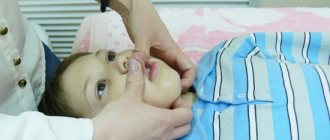Classification
Defects of hardness and softness can cover any pairs of sounds that differ in this characteristic. A lack of sound pronunciation may affect all speech phonemes (total) or only some (partial). According to their mechanism, hardness/softness disorders can be phonetic-phonemic (with impaired articulation and auditory perception) or purely phonemic (with impaired auditory differentiation):
- Replacing soft consonants with hard ones.
It occurs with insufficient bending and approach of the back of the tongue to the palate, as well as with hearing loss and unformed phonemic hearing (phonetic-phonemic defect). - Replacing hard consonants with soft ones.
Palatalization occurs due to excessive tension and excessive elevation of the middle part of the back of the tongue (phonetic-phonemic defect). - Mixing hard and soft phonemes with each other.
Implies both correct and incorrect use of pairs of sounds depending on their position in the word. Occurs in children with reduced hearing and undeveloped auditory differentiation (phonemic defect).
The development of a softening defect is predisposed by the child's immaturity of phonemic processes and speech kinesthesia, decreased physical hearing, disturbances in the structure of the articulation organs, and changes in the tone of the articulatory muscles. According to their psychological and pedagogical characteristics, such children belong to the FFN or ONR group.
Educational page
In the pronunciation of consonants having a hard (soft) pair, softening defects are observed
Most consonants in the Russian language have paired soft sounds. The exceptions will be the sounds Ш, Ж, Ц, which do not have soft pairs, and the sounds Ш, Ш, Ж, which do not have hard pairs. Soft consonants differ in articulation from paired hard consonants by an additional rise of the back of the tongue towards the hard palate, some (k'g'h') also by a noticeable movement of the tongue forward. What causes this defect? First of all, muscle tone disorders, the nature of which depends primarily on the location of the brain lesion.
Spasticity of the articulatory muscles - a constant increase in tone in the muscles of the tongue, leads to the fact that the tongue is tense, pulled back, its back is curved, raised upward, the tip is not pronounced.
Causes
Age-related speech imperfections
Softening (palatalization) of consonants or replacement of soft phonemes with hard ones is considered normal in physiological dyslalia. All children in their speech development go through the stage of age-related tongue-tiedness, caused by insufficient formation of the movements of the organs of articulation and phonemic hearing. Softened pronunciation is more common, but a defect in hardness is also possible. By about 4.5-5 years, as phonetic-phonemic processes improve, sound pronunciation defects disappear.
Dislalia
Defects in softening and hardness are characteristic of functional (acoustic-phonemic, articulatory-phonemic) and mechanical dyslalia. The direct producing factors are:
- unformed acoustic differentiation;
- weakness of the lingual muscles;
- gothic sky.
With unjustified palatalization of consonants, children's speech becomes “lisping”: “hoes” instead of “slippers”, “demik” instead of “house”. In the absence of softening, speech loses its smoothness, drawl, and melody. The child says “tota” instead of “aunt”, “lublu” instead of “love”. With dyslalia, polymorphic combined sound pronunciation disorders are often encountered, for example, sigmatism + rhotacism + softening defect.
Dysarthria
In dysarthria, a defect in softness or hardness may be due to increased tone (spasticity) or paresis of the tongue, hyperkinesis. In this case, the high muscle tone of the middle third of the back of the tongue causes softening of hard consonants (pseudobulbar dysarthria), and pareticism and lethargy causes the disappearance of palatalization (bulbar dysarthria). Similar disturbances are also observed with erased, cerebellar dysarthria.
Hearing loss
Reduced biological hearing - congenital or early-onset hearing loss in children - makes it difficult to perceive the speech of others and auditory control over one's own sound production. In hearing-impaired children, the softening defect is often combined with a voicing defect, sigmatism, rhotacism, and parasigmatism. There is a monotony and nasal voice.
Articulation gymnastics
Mom will be a speech therapist
To know which sound to start with, you need to consider:
- What sounds does the child pronounce most perfectly in order to obtain from them, based on the ready-made structure, the correct sound of a paired defective sound;
- The structure of which sounds allows you to most demonstrably show the difference between the articulation of paired hard and soft sounds.
The consonant sounds T, D, N are simple in their structure, therefore they are rarely defective and, in addition, are pronounced with half-open teeth and lips, which makes it possible to see changes in the position of the middle part of the tongue during the transition of the sound T to Т, Д к Дь, Н к NH. Thus, the selected sounds satisfy both conditions.
If you put two fingers (middle and index) on your tongue, you can feel the change in tongue tension tactilely.
In difficult cases, you can temporarily resort to mechanical help: offering to pronounce the syllables AT or TA repeatedly with the tongue resting on the lower teeth, lightly pressing with a finger or a spatula on the tip of the tongue. This will soften the sound T, that is, the syllables AT, TYA. By analogy, you can get the syllables AN, NYA, DYA.
While working with the sounds T, D, N, a kinesthetic feeling of tension and relaxation of the tongue should be developed, thanks to this, similar work on other sounds will be much easier and faster, but it is still necessary to check the correct pronunciation of the hard and soft pairs of all consonants.
Diagnostics
Speech therapy diagnostics should solve the following problems: identifying the cause of the softening defect and determining the range of concomitant speech disorders that need correction. Taking into account the expected etiofactors, the child may need to consult a pediatric neurologist, orthodontist, or otolaryngologist. The examination plan includes:
- Hearing examination.
Primary diagnostic information is obtained from a tuning fork hearing test and recording an audiogram. To determine the causes of hearing loss, a CT scan of the temporal bones may be informative. - Neurological examination.
In order to determine the form and severity of neurological disorders, electrophysiological diagnostics are prescribed: EEG, electroneuromyography. To identify focal lesions, neuroimaging diagnostics - MRI of the brain - is used. - Diagnostics of oral speech.
During a consultation, a speech pathologist-defectologist examines the structure of the articulatory apparatus, the mobility of the lips and tongue, the ability to hold and switch articulatory structures. Sound pronunciation and the ability to distinguish phonemes by ear are examined. All existing speech deficiencies are identified, and a plan for correctional and speech therapy work is drawn up.
Primary school “Healthy childhood” as a complete and additional education
Hurry up to sign up! Registration is open!
Dear mothers! We are pleased to inform you that you can attend the “Healthy Childhood” Primary School not only as a full-fledged education, but also as an additional education!!!
If you understand that your child is not coping with school, then the Speech Center is ready to come to your aid! You can attend the “Healthy Childhood” Primary School in your own way as additional education (help with learning difficulties, tutors, wellness).
Correction
Defects in hardness and softness are inevitably reflected in the writing. During schooling, children with such uncorrected problems are diagnosed with acoustic dysgraphia. Therefore, speech therapy classes must begin at an older preschool age. The individual route depends on the type of violation.
Preparation of organs of articulation
If palatalization of consonants is caused by high muscle tone of the back of the tongue, work must begin by relieving tension in its muscles. At the first stage, a relaxing massage of the tongue is carried out with an emphasis on the middle part, articulatory gymnastics (exercises “Spatula”, “Punish the naughty tongue”, “Let’s chew a pear” - “chewing” a medical syringe No. 1, stroking the tongue with the lips).
When the muscles of the tongue are softened and weak, on the contrary, the efforts of the speech therapist should be aimed at activating the lingual muscles. They resort to activating speech therapy massage and exercises (“Slide”, “Coil”, biting the tongue with teeth). In both cases, attention is paid to the development of soft motor skills and speech breathing.
Correction of phonemic processes
The differences between hard and soft consonants are explained to the child, and the main distinctive features of sounds are played out. Exercises are used to distinguish quasi-homonyms, show articulatory profiles, and work with paired pictures of mixed sounds. At this stage, it is important to develop visual and kinesthetic control in the child.
Development of correct articulatory patterns
To produce sounds, techniques of imitation and explanation, a mechanical method, are used. Different authors propose different sequences for practicing sounds with a softening defect. The most common scheme: anterior lingual, labiodental, labial, sibilant, sonorous. At the same time, a differentiation is made between non-palatalized and palatalized consonants, both aurally and in pronunciation.
Softening defect. Specifics of the work. methodological development in speech therapy on the topic
Slide 1
Speech prepared by: Shayakhmetova N.S. , teacher-speech therapist, MDOU “Combined Kindergarten No. 2 6”, Saratov Mitigation defect. Work specifics .
Slide 2
Softening defect. Nowadays, in practice, children with a softening defect are increasingly encountered, which manifests itself in a violation of the pronunciation of consonants that have a hard (soft) pair. The defect can be partial or total, i.e. cover all consonants. The exceptions will be the sounds Ш, Ж, Ц, which do not have soft pairs, and the sounds Х, Ш, Ж, which do not have hard pairs. If a child has a softening defect, then we begin our work with it, having previously worked with vowel sounds. Complete elimination of the defect at an early stage in oral speech will prevent the appearance of acoustic dysgraphia in written speech. Correction of the softening defect is carried out in individual lessons.
Slide 3
Factors predisposing to the occurrence of a defect: Decreased physical hearing Immaturity of phonemic processes Impairment in the structure of the articulatory apparatus Impaired innervation (tone) of the articulatory muscles
Slide 4
Types Among the softening defects the following are observed: 1. Complete absence of soft consonant sounds in speech, that is, their constant replacement with paired hard sounds (Uncle Vanya - dada Vanna, five - pat, meat - maso, etc.). Phonetic-phonemic defect; 2. Excessive softening (The dog is going home - The dog is going straight). In practice, it is more common, it is also called a hardness defect. Phonetic-phonemic defect; 3. Mixing of soft and hard sounds in speech (paralalia), that is, along with the correct pronunciation of hard and soft consonants, deviations are observed in both directions. Phonemic defect.
Slide 5
Features of articulation When pronouncing soft sounds, a feature of articulation is palatalization - (from the Latin softening) additional to the main articulation of consonants, the rise of the middle part of the tongue to the hard palate (or iota articulation). The simplest in terms of articulation are the anterior lingual sounds T-T, D-D, N -Нь, they are similar in articulation (rarely broken). hard soft The profiles show that the transition of a hard consonant sound to a soft one depends on the tension and rise of the middle part of the tongue to the palate. Let us consider in the table what happens when there is a defective pronunciation of paired consonant sounds.
Slide 6
Table In case of defective pronunciation of consonants: Hard Soft in pronunciation soft hard defect of hardness softening tongue tense spastic curved (palatalization) relaxed soft flat middle part of the back of the tongue does not fall does not rise does not bend the tip of the tongue is not expressed tone increased hypertonicity decreased hypotonicity
Slide 7
Specifics of work Violations in the pronunciation of hard and soft consonants, as a rule, arise from deficiencies in acoustic differentiation, as well as from disturbances in the innervation of the articulatory muscles. Thus, work to correct softening defects is carried out in two directions: 1) correction of phonemic hearing and phonemic perception; 2) development of the correct articulatory structure when pronouncing paired consonants. When correcting phonemic hearing and phonemic perception, it is important to achieve the child’s understanding of the principle of distinguishing between hard and soft sounds. It is necessary to explain to the child and show with examples that incorrect pronunciation of sounds can change the meaning of the entire word. To facilitate this task, you can use graphic material, thematic pictures, and accompany the exercises with certain movements. All this is done to ensure visual and kinesthetic control.
Slide 8
Stages of work (classic) 1. Complete absence of soft consonant sounds 2. Excessive softening of sounds 3. Mixing of soft and hard sounds in speech 1. Preparatory stage 2. Stage of sound production 3. Stage of sound automation 4. Stage of differentiation of sounds 5. Stage of skill development self-control (according to Arkhipova) 4. Stage of differentiation of sounds 5. Stage of developing self-control skills (according to Arkhipova) At the stage of differentiation of sounds, it is important to work more carefully and not only in hearing, but also in pronunciation!
Slide 9
Preparatory stage At stage 1, we initially form in the child the concept of softness and hardness. You can show: balls - plastic and rubber or cubes - wooden and rag. The whole range of speech therapy work is carried out here - this includes the normalization of muscle tone of facial and articulatory muscles (statics, dynamics), work on breathing and the development of fine motor skills, etc. When selecting articulation exercises, we take into account the structure of the violation in pronunciation: 1. No soft ones 2. Excessive softening It is necessary to strengthen the muscles of the tongue and develop a rise in the middle part of the back of the tongue. You need to relax the muscles of the tongue, learn to lower the middle part of the back of the tongue and straighten it. Teach the tongue to move back and forth: tense, relaxed Tongue position Curved “Slide” Straight “Scapula”
Slide 10
Articulation exercises No soft Excessive softening House opens Curious tongue Smile - Proboscis Grin Pull the tongue to the chin Monkey Pull the tongue to the nose Bulldog Hamster Circle Fat-skinny Balls lower We clean the teeth (outside) upper Samovar Slide The wind blows from the slide Reel Chew a pancake Snake Punish the tongue Spatula Blowing on the shoulder blade Bite your tongue Pendulum Needle Swing Exercises for setting the required sound
Slide 11
Normalization of muscle tone The main task in case of a softening defect is to teach the child to be able to redistribute muscle tension in the articulatory apparatus. It is very effective to use isotonic exercises with resistance and counteraction here, because... They both strengthen and relax muscles. You can use cotton swabs in the work as in the picture, or your tongue in the “Slide” position, and the stick under the tongue. In more stubborn cases (without dynamics), you can use elements of speech therapy massage with classical techniques: in the first case, when there are no soft ones - activating (strengthening), in the second - relaxing. It can only be performed after consulting a neurologist; if there are no contraindications, it is better to have a certificate. In our work we don’t always have time for this, so we recommend it to parents. Another type of speech therapy massage is self-massage, which we can do both individually and with a group. (description in the memo). All this is described in more detail in the book by O.I. Krupenchuk “Correcting the pronunciation.” Isotonic exercises and self-massage are there in poetic form. There are also many books by various authors about massage: E.F. Arkhipova, E.A. Dyakova, I.V. Blyskina, etc. There is also a lot of information on the Internet.
Slide 12
Subsequent stages At subsequent stages we work using known methods. At the differentiation stage, do not forget about differentiation in pronunciation! You can show profiles or on hippo. To differentiate hard whistling [s], [z] from soft sounds, the front part of the back of the tongue is as close as possible to the incisors and the tongue bends more strongly and rises to the palate. When pronouncing the sounds [k], [g], [x], their soft pairs differ in that the tip of the tongue is pressed against the lower teeth. When moving from [m] to [m] ' - the tip of the tongue is pressed against the lower teeth and the back is arched, the tension of the lips also changes. When working on the vibrant [r], you should pay attention to the fact that during the transition from [r] to [r]' the tongue noticeably moves forward towards the upper incisors. With [l] to [l] ' on the contrary - back.
Slide 13
Recommendations from scientists. Tatyana Borisovna Filicheva recommends correcting the softening defect using vowels [И] and [И]. To consolidate the concept of hardness and softness on the basis of preserved consonant sounds [K], [V], [P], [B], etc. (This technique is ineffective when working with front-lingual [T], [D], [N]) Marina Anatolyevna Polyakova recommends producing soft and hard sounds based on the muscular sensations of hardness and softness. Where to start from the labial and labiodental. Place in pairs in the following sequence [M], [B], [P], [V], [F], [N], [D], [T]. Olga Vladimirovna Pravdina recommends that sounds be staged taking into account: 1. Already correctly staged, based on a ready-made articulatory pattern. 2. By contrasting which sounds the difference between paired soft and hard sounds will be more clearly visible. The consonants [T], [D], [N] satisfy both conditions. If you put two fingers (middle and index) on your tongue, you can feel the change in tongue tension tactilely. While working with these sounds, a kinesthetic feeling of tension and relaxation of the tongue should be developed, thanks to this, similar work on other sounds will be much easier and faster. Fedor Andreevich Rau, taking into account the complexity of articulation, recommends correcting the defect in the following sequence: [T] - [T '], [D] - [D'], [N] - [N'], [F] - [F'], [V] - [V'], [P] - [P'], [B ] - [B'], [M] - [M'], [C] - [S'], [Z] - [Z'], [L - [L'], [P] - [P'] .
Slide 14
Literature...
Slide 15
Additions... The self-massage complex includes exercises for the lips, cheeks, tongue, lower jaw and neck muscles. Relaxation of the cervical muscles reflexively causes relaxation of the muscles of the root of the tongue. This is done in a sitting position: 1. Dropped your head - “fell asleep.” 2. Threw it back - shook it left and right. 3. They lowered it and also shook it. In self-massage, children cannot stroke the back of the neck on their own, which is also very important, so I supplement this with my own hands and also use a massager. The memo also describes an exercise for spreading the tongue: “Let’s chew a pear” - not very aesthetically pleasing, but effective! For this, you can also use a probe substitute - “Racket”, a wooden disposable spatula. From acupressure, you can use massaging points in the area of the submandibular fossa, with two index fingers for 5-15 seconds: with continuous vibration, we relax the muscles of the tongue, with intermittent vibration, we strengthen. For fine motor skills, balls are hedgehogs. You can beat blue and green at the differentiation stage. Also a pop-up ball. To form the correct air stream, a pencil with a pinwheel, etc. Tomilina’s “Klyuvik” probe for setting C L, “Hedgehog” probe.
Slide 16
Thank you for your attention!
Slide 17
References 1. Akimenko V.M. New speech therapy technologies: educational method. allowance / V.M. Akimenko. - Rostov n/d: Phoenix, 2008. - 105 p.: ill. - (I give my heart to the children). 2. Arkhipova E.F. Speech therapy massage for dysarthria M.: AST: Astrel; Vladimir: VKT, 2008. 3. Blyskina I. V. An integrated approach to the correction of speech pathology in children. Speech therapy massage: A manual for teachers of preschool educational institutions. SPb.: “CHILDHOOD-PRESS”, 2008. 4. Dyakova E.A. Speech therapy massage. 4th ed. - M.: Academy, 2012. 5. Krupenchuk O.I., Vorobyova T.A. Correcting pronunciation: A comprehensive method for correcting articulation disorders. - St. Petersburg: Litera Publishing House, 2010. 6. Krause E.N. “Speech therapy. Speech therapy classes with children of early and younger age" - St. Petersburg: CORONA print; M.: Binom Press, 2005 7. Miklyaeva Yu. V. Speech therapy massage and gymnastics. Work on sound pronunciation. - M.: Iris-press, 2010. - (Popular speech therapy). 8. Novikovskaya O.A. “Fun exercise for the tongue” - M.: AST, St. Petersburg: Sova, 2010. 9. Povalyaeva M.A. “Complete reference book. Speech therapist's handbook" - M.: AST: Astrel: Poligrafizdat, 2010 10. Polyakova M.A. tutorial 11. Rossiyskaya E.N., Garanina L.A. Pronunciation side of speech: Practical course. – M.: ARKTI, 2003. + Novikova E.V. Articulation of sounds in a graphic image. Educational and demonstration material. Supplement to the book “Speech Therapy ABC” - M.: 2000. + sites on massage, training
Slide 19
Stage of production of sounds We use techniques: imitation and demonstration of articulation; in a syllable using vowels [И] – [И]; with mechanical assistance; using a temporary version (for sounds [Л], [Ль]) A technique based on imitation involves auditory perception of soft (hard) sounds and visual perception of the articulation of these phonemes. It should be explained to the child that when pronouncing hard sounds, the tongue has a flat shape (show), when pronouncing soft sounds, the tip of the tongue rests on the lower incisors, and the back arches towards the hard palate. In the case of the labials, it’s the same, only behind closed lips. In a syllable using vowels [I] - [Y], described in more detail in the technique of T.B. Filicheva. Some nuances in staging with mechanical assistance...
Slide 20
Mechanical method The placement of velar [k], [g], [x] is made from the base syllables: [k] from -" ta -" tya -" kya -" ka [g] from -" yes -" dia -" gya - "ga [x] from -" sa -" xia -" hya -» ha. At the moment of pronouncing a syllable, the speech therapist gradually moves the tongue back, into the depths of the mouth, pressing the front part of the back of the tongue with the child’s index finger to the second phalanx. If there is a softening defect, correction should be carried out according to Filicheva’s method. Setting up front-lingual [t'], [d'], [n'] O.V. Pravdina suggests the following: pronounce the syllables AT or TA repeatedly with the tongue resting on the lower teeth, lightly pressing with a finger or spatula on the tip of the tongue. This will soften the sound T, that is, the syllables AT, TY. By analogy, you can get the syllables AN, NYA, DYA. With mechanical assistance, at the initial stage it is possible to obtain [l'] with the back of the tongue strongly curved towards the hard palate, when setting up a temporary lower version of the articulation of this sound. You should keep the tip of your tongue down with a spatula. At the same time, we focus on the fact that the tip of the tongue rests on the lower incisors, and the front part of the back forms a closure with the alveoli. The hard sound [l] is placed from the interdental vowels [a] or [s], having previously specified their articulation: a-l, small, given; y—l, washed. After a clear differentiation of hard and soft sounds, we will be able to move from the lower articulation [l] to the more convenient upper one while maintaining the necessary elevation of the back of the tongue and a significant area of its contact with the palate.








